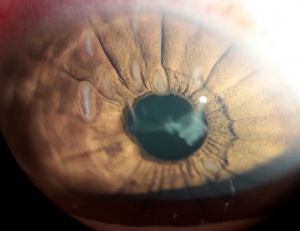A persistent condition known as filamentary keratitis causes adherent filaments of mucus and corneal epithelium to form on the corneal surface. The mucous and degenerated epithelial cells that make up filaments are linked to the ocular surface at one end. On the anterior surface of the cornea, filaments appear as tiny, gelatinous strands that might vary in size, shape, composition, and distribution.
Conjunctival goblet cells may produce more mucus if they are unable to produce tears. The aberrant debris and mucous strands that form corneal filaments in aqueous-deficient eyes are abundant and attach strongly to the injured corneal epithelium and basement membrane. Under the connection to the corneal epithelium, there may be grey sub-epithelial granular opacity. After establishing themselves, corneal filaments cling strongly to the underlying corneal epithelium. Pain, epithelial tears, and inflammation are caused by friction between corneal filaments and the upper lid, which promotes more filament development.
Patients with filamentary keratitis frequently experience severe symptoms, including persistent foreign body sensation, redness, and light sensitivity that can range from mild to severe. They may also experience blurring of vision and blepharospasm (abnormal contraction of eyelid muscles), increased blinking, and lacrimation or watering.
The irritation in eyes is exacerbated by blinking and is usually present throughout the day. Patients may not have symptoms with their eyes closed. A variety of diseases or conditions affecting the ocular surface are linked to filamentary keratitis.
Aqueous tear shortage, as in keratoconjunctivitis sicca. Systemic diseases that affect the ocular surface, such as Sjögren syndrome. exposure of the cornea similar to seventh cranial nerve paralysis cataract surgery (E.g keratoplasty, cataract surgery). long-term use of anti-cholinergic medications. Poor tear distribution and decreased oxygenation of the corneal epithelium may result from ptosis (drooping) of the upper eyelids are the most common risk factors for the development of filamentary keratitis.
The filaments can range in length from 0.5mm sessile adhesions to 10mm long threads and have a gelatinous, refractile look. Typically, filaments have one end that is fixed to the corneal epithelium’s basement membrane and an open other end. The majority of the anomalies in the basement membrane that are connected to hypertonic tear film conditions are associated with filamentary keratitis. With eyelid movement, filaments elongate and coil.
The condition that filamentary keratitis is most usually linked to dry eye. Reduced aqueous tear secretion or higher tear film stasis cause a rise in tear film osmolarity, which increases the mucous to aqueous ratio. This unbalanced ratio of mucus to tears causes epithelial cells to slough off and results in epithelial abnormalities. Exfoliated epithelial cells are disposed of in the mucous. Increased mucous viscosity increases its ability to cling to flaws in the corneal epithelium, which increases the chance of filament development.
At The Eye Center- Dr. Mahnaz Naveed Shah & Associates our team of eight ophthalmology subspecialists/ eye specialists, eye surgeons who are considered amongst the very best eye specialists in Karachi and in Pakistan, have the diagnostic and treatment capabilities to treat from the simplest to the most complex patients. We work hard to provide our patients with the best possible medical and surgical eye care, in a state of the art purpose built eye care facility. We offer the entire array of medical, laser and surgical treatments to help provide patients the best possible care in the most efficient, safe and ethical manner.
If you need an appointment, please contact us at 03041119544 during our working hours or leave us a WhatsApp message at +923028291799 and someone will connect with you. Walk-in appointments are also available for emergencies. We can also be reached through our web portal on www.surgicaleyecenter.org


